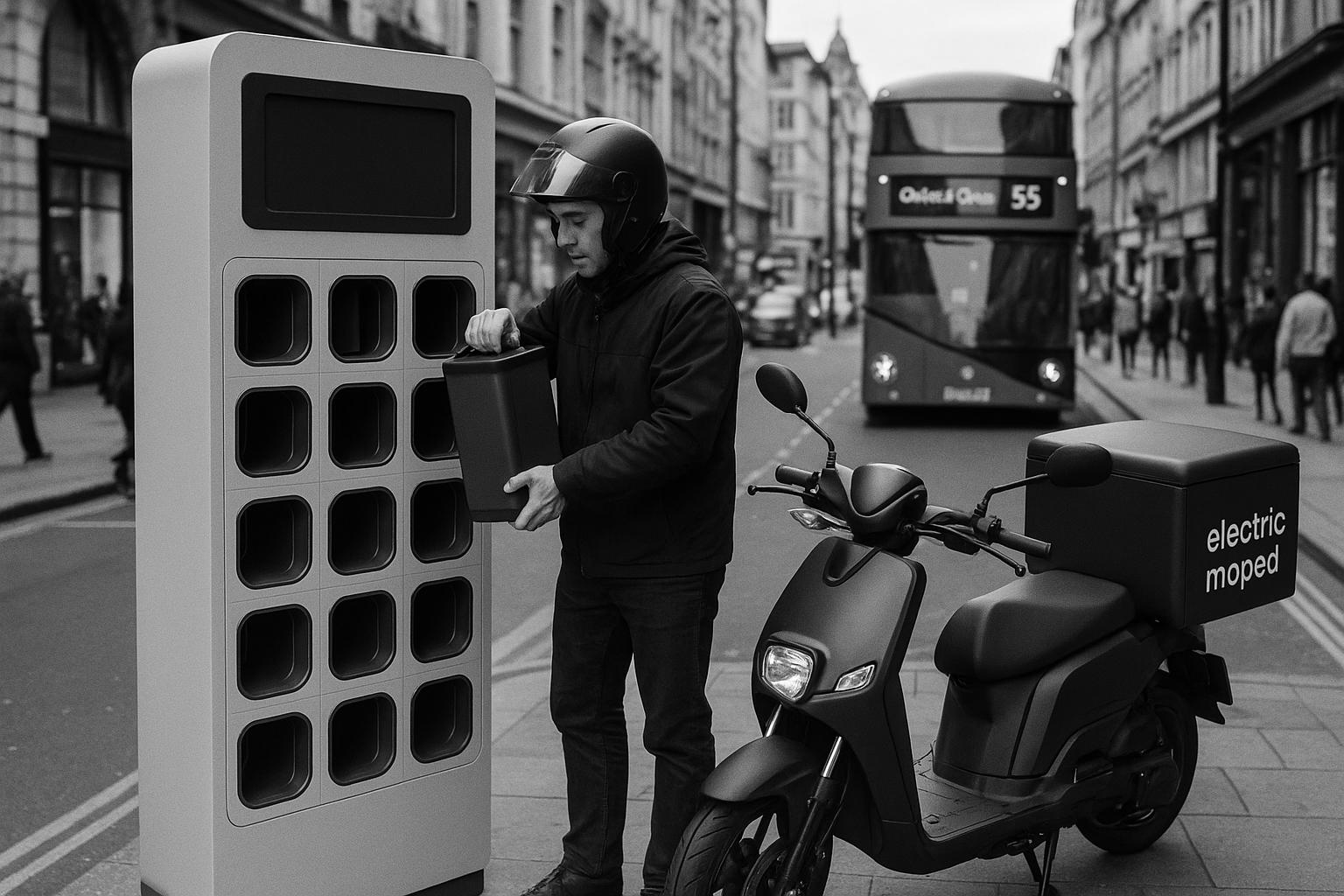Uber is trialling rapid battery swaps for electric mopeds in London this autumn, the first such service in the UK, while also boosting EV charging infrastructure through partnerships and multimillion-pound investments to accelerate its transition to an all-electric platform by 2025.
Uber is intensifying its drive towards electrification by launching a battery-swapping pilot for electric moped couriers in London, a significant step in its broader strategy to transform its European courier and driver network. Set to begin this autumn, the pilot, conducted in collaboration with global e-mobility provider Vmoto, aims to tackle the downtime typically caused by charging delays. Couriers will have the option to quickly exchange depleted batteries for fully charged ones at dedicated stations, a convenience already established in several Asian markets. This initiative is a first for the UK and forms part of Uber Eats’ ambition to transition 100,000 of its moped and motorbike couriers across Europe to electric vehicles by 2030.
Through the partnership, couriers in major cities—including London, Amsterdam, Berlin, Brussels, Lisbon, Madrid, and Paris—will benefit from exclusive discounts on the upfront cost of electric mopeds, as well as lower maintenance and charging expenses. These financial incentives are designed to save couriers several hundred pounds or euros annually. Graziano Milone, Vmoto’s president of strategy and business development, expressed pride in working with Uber on this ambitious project, highlighting the shared mission to make urban e-mobility simpler, greener, and more cost-effective while improving job quality through increased operational efficiency.
Beyond expanding electrification among couriers, Uber is also focusing on improving electric vehicle charging accessibility for its car drivers. In a newly announced partnership with C40 Cities—an alliance of leading cities committed to addressing climate change—Uber plans to enhance home and neighbourhood charging infrastructure in London, Boston, and Phoenix. This collaboration will push for policy reforms to boost residential charging availability and introduce a digital tool called the Electric Vehicle Infrastructure Estimator (EVIE). This tool helps municipalities and utilities forecast future charging demands, particularly from high-mileage Uber drivers, who tend to log three times more miles than typical private motorists. The initiative aims to support at least 55,000 drivers across the three cities, with a strong emphasis on accelerating the shift to clean transportation and improving urban air quality.
Uber’s global head of sustainability, Rebecca Tinucci, underlined the importance of reliable and accessible charging, saying: “Reliable, accessible charging will help accelerate economic opportunity for thousands of drivers and create healthier communities in the process.” This approach is critical, considering the significant mileage Uber drivers cover, which amplifies both the opportunity and necessity for expanding EV infrastructure.
This latest push builds on Uber’s earlier investments in EV charging infrastructure. In 2022, the company committed £5 million to install over 700 new electric vehicle chargers across three London boroughs—Newham, Brent, and Redbridge—targeting areas with the highest demand from drivers lacking home charging options. These on-street chargers increased the city’s EV network by more than 7%, offering much-needed support to drivers transitioning to electric vehicles. Recent updates from Redbridge reveal the installation of 34 new dual 22kW fast chargers, doubling access points and further expanding the borough’s capacity to support EV users, with plans for an additional rollout of 174 fast chargers across 87 locations by the end of 2024. The charging infrastructure initiative exemplifies Uber’s ongoing commitment to making EV ownership and use more practical and affordable for its extensive network of drivers.
Uber’s larger ambition is reflected in its efforts in London, where the company aims to operate an all-electric platform by the end of 2025. The number of EVs available through Uber in the capital has already tripled, with over 5,000 electric vehicles collectively driving more than one million miles monthly. This surge aligns with Uber’s goal to make greener trips the norm and drastically reduce its carbon footprint.
Taken together, these developments underline Uber’s multifaceted approach to electrification—blending technology, policy advocacy, infrastructure investment, and partnerships—to drive sustainable urban transport solutions across Europe and beyond.
 Reference Map:
Reference Map:
- Paragraph 1 – [1], [2]
- Paragraph 2 – [1], [2]
- Paragraph 3 – [1], [2]
- Paragraph 4 – [1], [2]
- Paragraph 5 – [1], [3], [4], [5], [6]
- Paragraph 6 – [7], [1]
Source: Noah Wire Services
- https://www.sustainabletimes.co.uk/post/uber-launches-battery-swap-mopeds-and-boosts-ev-charging-in-london – Please view link – unable to able to access data
- https://www.sustainabletimes.co.uk/post/uber-launches-battery-swap-mopeds-and-boosts-ev-charging-in-london – Uber is enhancing its efforts to electrify its courier and driver network by launching a battery-swapping pilot in London for electric moped couriers, in partnership with global e-mobility provider Vmoto. This initiative is part of Uber Eats’ broader goal to help 100,000 of its moped and motorbike couriers across Europe switch to electric vehicles by the end of the decade. The collaboration offers exclusive discounts on the upfront cost of electric mopeds, along with reduced maintenance and charging costs, aiming to save couriers in major European cities, including London, hundreds of pounds or euros each. The battery-swapping pilot, set to launch in London this autumn, is designed to eliminate downtime caused by charging. Couriers will be able to swap depleted batteries for fully charged ones at dedicated stations, a model already proven in many of Uber Eats’ Asian markets. This marks the first time this approach is being tested in the UK. Vmoto’s president of strategy and business development, Graziano Milone, expressed pride in collaborating with Uber on this ambitious project, emphasizing their commitment to improving urban e-mobility by making it simpler, more sustainable, and more affordable, while enhancing the quality of work for many users by optimizing efficiency. Beyond couriers, Uber is also expanding efforts to support its car drivers with better access to EV charging. In a newly announced collaboration with C40 Cities, Uber plans to improve home and neighbourhood charging availability in London, as well as in Boston and Phoenix in the United States. As part of the initiative, Uber and C40 will collaborate to advocate for policy reforms that enhance the availability of residential charging infrastructure. They’ve also developed a new digital tool, the Electric Vehicle Infrastructure Estimator (EVIE), which helps cities and utilities predict and plan for future charging demand, particularly from high-mileage Uber drivers. The target is to reach at least 55,000 drivers across the three cities. Given that Uber drivers log three times more miles than the average private vehicle owner, expanding their access to charging could deliver a significant boost to local air quality. Uber’s global head of sustainability, Rebecca Tinucci, stated, “We’re proud to partner with C40 and city leaders to help unlock EV infrastructure where it is most needed. Reliable, accessible charging will help accelerate economic opportunity for thousands of drivers and create healthier communities in the process.” This isn’t Uber’s first foray into infrastructure investment. In 2022, the company committed £5 million to expand EV charging in three London boroughs—Newham, Brent, and Redbridge—by installing over 700 new chargers where driver demand was highest.
- https://www.uber.com/en-GB/newsroom/uber-joins-london-boroughs-in-5-million-ev-charger-boost – Uber has announced a £5 million investment to install over 700 electric vehicle (EV) chargers across north and east London, following a landmark agreement with three London boroughs. These chargers will be installed on streets in Newham, Brent, and Redbridge, boosting London’s overall charging network by over 7%. The initiative aims to improve access for drivers without driveways or home chargers. Uber’s General Manager for Northern and Eastern Europe, Jamie Heywood, emphasized the importance of reliable charging near drivers’ homes in encouraging the switch to electric vehicles. The project is part of Uber’s broader efforts to support the transition to EVs and reduce emissions in the capital.
- https://www.electrive.com/2022/03/11/uber-invests-5-million-installing-700-chargers-in-london/ – Uber is investing £5 million to install 700 electric vehicle (EV) chargers across London, focusing on the boroughs of Brent, Newham, and Redbridge. The chargers will be installed on streets to improve access for drivers without driveways or home chargers. Uber is collaborating with the boroughs to determine optimal installation locations. The chargers are expected to be operational by 2023, though the specific charge point manufacturers have not been disclosed. This initiative aims to enhance the city’s EV infrastructure and support the adoption of electric vehicles among London drivers.
- https://www.redbridge.gov.uk/news/may-2024/new-fast-ev-chargers-installed-in-redbridge-following-landmark-project-with-uber/ – In May 2024, Redbridge installed 34 new 22kW dual fast electric vehicle (EV) chargers as part of a partnership with Uber. These chargers allow two vehicles to be charged simultaneously, providing a total of 68 charge points. The chargers are available to all EV drivers, subject to local parking restrictions. Further chargers are planned to be rolled out under the project, bringing a total of 174 new fast chargers to 87 locations around the borough by the end of 2024. The project is fully funded by Uber, with Believ responsible for installation, operation, and maintenance.
- https://www.standard.co.uk/news/tech/uber-ev-electric-vehicles-charge-points-b1030694.html – Uber has invested £5 million to install over 700 electric vehicle (EV) chargers across north and east London, boosting the capital’s charging network by over 7%. These on-street chargers will provide access for drivers without driveways, benefiting both Uber drivers and residents. The chargers are being installed in collaboration with the boroughs of Newham, Brent, and Redbridge, where there is significant demand for charging points. The initiative aims to encourage more drivers to switch to EVs and improve air quality in the city.
- https://www.theguardian.com/environment/2023/jun/08/uber-aims-for-greener-trips-and-to-expand-london-electric-vehicle-fleet – Uber is aiming to expand its electric vehicle (EV) fleet in London and promote greener trips. The company plans to become an all-electric platform in the capital by the end of 2025. Uber has already tripled the number of EVs on its app since the launch of Uber Green, with over 5,000 EVs now driving more than one million miles per month in London. The company is also working on installing more public EV chargers to support this transition, with a £5 million investment in over 700 chargers across north and east London.
Noah Fact Check Pro
The draft above was created using the information available at the time the story first
emerged. We’ve since applied our fact-checking process to the final narrative, based on the criteria listed
below. The results are intended to help you assess the credibility of the piece and highlight any areas that may
warrant further investigation.
Freshness check
Score:
8
Notes:
The narrative presents new information about Uber’s upcoming battery-swapping pilot in London, set to launch this autumn, marking the first such initiative in the UK. While similar initiatives have been reported in other European cities, this specific development appears to be original. The article also references Uber’s previous £5 million investment in EV charging infrastructure in London, indicating a continuation of their electrification efforts. However, the article does not provide a specific publication date, making it challenging to assess the exact freshness. The absence of a publication date is a notable concern.
Quotes check
Score:
7
Notes:
The article includes a direct quote from Graziano Milone, Vmoto’s president of strategy and business development, expressing pride in collaborating with Uber on the project. A search for this quote reveals no exact matches in earlier publications, suggesting it may be original. However, without a publication date, it’s difficult to confirm the originality of the quote. The lack of a publication date raises concerns about the freshness and originality of the content.
Source reliability
Score:
6
Notes:
The narrative originates from Sustainable Times, a platform dedicated to sustainable investment and startup news. While the platform focuses on sustainability topics, it is not widely recognized among major news outlets, which may affect its credibility. The absence of a publication date further complicates the assessment of the source’s reliability.
Plausability check
Score:
8
Notes:
The claims about Uber’s partnership with Vmoto for a battery-swapping pilot in London align with Uber’s known commitment to electrification and previous investments in EV infrastructure. The article also mentions Uber’s collaboration with C40 Cities to enhance EV charging infrastructure, which is consistent with Uber’s ongoing efforts to support EV adoption. However, the lack of a publication date makes it challenging to verify the timeliness and accuracy of the information.
Overall assessment
Verdict (FAIL, OPEN, PASS): OPEN
Confidence (LOW, MEDIUM, HIGH): MEDIUM
Summary:
The narrative presents plausible information about Uber’s initiatives to enhance EV infrastructure in London, including a new battery-swapping pilot and a partnership with C40 Cities. However, the absence of a publication date and the source’s limited recognition raise concerns about the freshness and reliability of the content. Further verification from more established news outlets is recommended to confirm the details and assess the credibility of the information.













